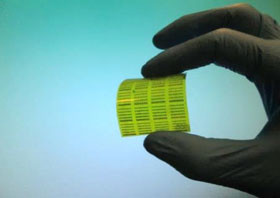Inkjet-printable electronics on the way

Researchers from Germany and Canada are paving the way for mass-producing printable electronics by demonstrating a fully inkjet-printable flexible resistive memory. Their proof of concept has been published in the journal Applied Physics Letters.
Memory devices have in recent years undergone an exponential increase in integration in low-performance applications, such as credit cards and in-home appliances. Additive manufacturing has meanwhile experienced a boom of its own, allowing for a streamlined process flow that eliminates complex lithography and material removal steps at the detriment of feature size, which is in many cases not critical for memory devices in less computationally demanding uses.
As memory devices have become more flexible, their ease of fabrication and integration in low-performance applications has generally been treated as being of secondary importance. But now, thanks to the work of researchers at Munich University of Applied Sciences (MUAS) in Germany and INRS-EMT in Canada, this is about to change.
Inkjet printing is a common office technology that competes with laser printing, offering the added benefit of a straightforward transfer from inkjet to roll-to-roll printing. The research group now presents a resistive memory (ReRAM) proof of concept that paves the way for mass-producing printable electronics.
The basic principle behind the group’s ReRAM is simple, said INRS-EMT doctoral student Bernhard Huber: “In any kind of memory, the basic memory unit must be switchable between two states that represent one bit, or ‘0’ or ‘1’. For ReRAM devices, these two states are defined by the resistance of the memory cell.”
For the conductive-bridge random access memory (CB-RAM) used by the group, ‘0’ is “a high-resistance state represented by the high resistance of an insulating spin-on glass, which separates a conducting polymer electrode from a silver electrode”, said Huber. “The ‘1’ is a low-resistance state, which is given by a metallic filament that grows into the spin-on glass and provides a reversible short-circuit between the two electrodes.”
Rather than printing colours, “We use functional inks to deposit a capacitor structure — conductor-insulator-conductor — with materials that have already been deployed in cleanroom processes,” Huber said. “This process is identical to that of an office inkjet printer, with an additional option of fine-tuning the droplet size and heating the target material.”
So what is the significance of the group’s work?
“We not only demonstrated that a complete additive [printing] process was possible but also that the performance parameters are comparable to cleanroom-fabricated devices,” said Christina Schindler of MUAS. “The biggest technological appeal is the mechanical flexibility of our memory tiles, and the fact that all materials required for processing are commercially available.”
According to Schindler, the team’s biggest surprise was how little device performance depends on the fabrication process. This means the printing process could lead to the production of low-cost flexible electronics and even print-on-demand electronics, with Schindler suggesting applications such as supermarkets printing their own smart tags or public transport providers customising tickets on demand. The researchers further suggest that the costs for an additive printer, after optimisation of the process steps, could drop to within the range of current inkjet printers.
Nanoscale pixels to advance augmented reality eyewear
Physicists have developed extremely small pixels that can be used in compact AR glasses, using...
Novel semiconductor shows superconducting promise
Researchers from The University of Queensland have demonstrated superconductivity in...
Light-controlled ferroelectrics for future electronics
Researchers have discovered a way to manipulate the properties of ferroelectric materials quickly...






